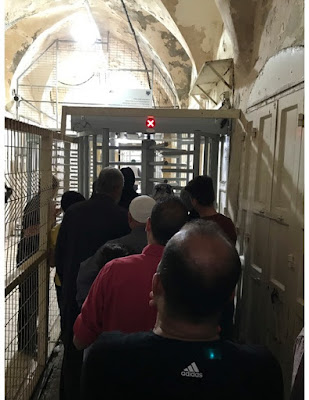The report quotes a 2007 Israeli Assistant Minister of Defense saying: "There is no written order to empty Hebron of Arabs, but that's the greatness of military rule. It can simply refrain from doing: it can refrain from enforcing the law on settlers and it can refrain from allowing Palestinians to move around."
The B'Tselem report focuses on the old city of Hebron but also notes that Israel pursues similar policies in other parts of the West Bank and East Jerusalem, i.e., policies aimed at making people leave by creating unbearable living conditions.
Thus, Forcible Transfer may be added to the other crimes committed by Israel under article 49 of the Fourth Geneva Convention, namely: transfer of an occupying power's citizens into the occupied territory (the settlements); transfer of prisoners from the occupied territory to the occupying country; and indifference to the welfare and abuse of the people in the occupied territory.
A little more background about Hebron and the hardships faced by the Palestinians there is helpful in understanding what is happening in Hebron.
Hebron is divided into two parts H1 and H2. H1 has about 400,000 Palestinians and is nominally controlled by the Palestinian Authority. H2 contains the old city of Hebron and five Israeli settlements. About 30,000 Palestinians and 200 to 800 settlers live in H2. H2 is controlled by the Israeli military and border police.
Map of Hebron from B'Tselem report.
The pale grey area is the area of maximum Palestinian movement restriction. The dark blue, light blue and dark gray areas are settlement areas. The colored roads are roads on which Palestinian foot traffic and vehicular traffic are restricted.
Movement into and through the old
city is severely restricted: the five settlements in the city center are
surrounded by impenetrable walls and razor wire; 22 checkpoints throughout the
old city are staffed by Israeli military and border police who demand ID and
carry out frequent body and bag searches; many streets are closed to
Palestinian pedestrian and vehicular traffic; and 64 barriers keep Palestinians from major streets and the vicinity of settlements. These movement restrictions impede children going to school and
people doing their shopping, visiting friends, visiting family or going to
worship. It is humiliating for people to be subjected to ID checks, body
searches and checkpoint closures by a hostile and essentially foreign power as
they try to move about in their own city.
Palestinians waiting at a checkpoint to worship at the Al Ibrahimi mosque.
Activity in the old city is
continuously monitored from checkpoints, watchpoints on top of Palestinian
buildings and cameras throughout the old city. The matrix of control established by checkpoints, cameras,
watchpoints, settlements, barriers and roadblocks are nicely shown as PDFs in interactive maps produced by the
Hebron Human Rights Defenders at their website https://www.hebronapartheid.org .
Two of my previous blogs described
Israeli settler violence against the families of Hani Abu Haikel and Emad Shamsiyeh in Tel Rumeida. The B'Tselem report and the above Human Rights Defenders website describe similar cases of settler violence against other families in
Hebron.
The Israeli military is complicit
in the oppression of Palestinian families. Although they sometimes intercede to
prevent acts of settler violence, they usually do nothing to stop it. Relations between settlers and soldiers are close. For example, the settlers took
over a Palestinian building and made it into a place for rest and relaxation of Israeli
soldiers. The settlers bring cakes to soldiers and invite
them into their homes for meals that are much better than military fare. The settlers know that the soldiers are there to serve them.
The Israeli military are more than passive observers of settler violence. They also engage directly in arbitrary arrests, home intrusions, home demolitions and harassment of Palestinians, as richly documented by Breaking the Silence, an
organization of former Israeli soldiers that began in Hebron. Breaking the Silence seeks to "... expose the Israeli public to the reality of everyday life in the Occupied Territories.." and to show "...the price paid for a reality in which young soldiers face a civilian population on a daily basis, and are engaged in the control of that population's everyday life." They are opposed to the occupation.
The hardships, the movement restrictions, the shutting down of shops and streets have changed what was once a thriving market center for the entire Southern West Bank into a ghost town.
The hardships, the movement restrictions, the shutting down of shops and streets have changed what was once a thriving market center for the entire Southern West Bank into a ghost town.



It’s impossible to walk down Shuhada St. in Hebron and not feel something terrible is afoot – thanks for explaining H1 and H2.
ReplyDelete